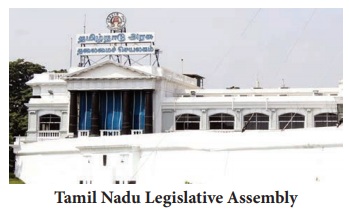State Government of India - The State Legislature | 10th Social Science : Civics : Chapter 3 : State Government of India
Chapter: 10th Social Science : Civics : Chapter 3 : State Government of India
The State Legislature
The State Legislature
The
Constitution provides a legislature for every state. Most of the States have
only unicameral legislature i.e., Legislative assembly. Some State has
bicameral legislatures (example Bihar, Karnataka, Maharashtra, Uttar Pradesh,
Andhra Pradesh and Telangana). The lower house, legislative assembly represents
the people of the state the upper house; Legislative Council represents special
interests like teachers, graduates and local governments.

In Tamil Nadu, according to the strength
of Legislative Assembly (234 members), the number of ministers may be up to 36,
i.e. 15 percent of 234.
The Legislative Assembly (Lower House)
The
Legislative Assembly is a popular house. It is the real centre of power in the
State. It consists of members directly elected by the people on the basis of
adult franchise. The strength of the Assembly varies from State to State
depending on the population. However the maximum strength of the Assembly must
not exceed 500 or its minimum strength not be below 60. The term of office of
the legislative assembly is 5 years. It can be dissolved even before the expiry
of its term.
The size
of the Legislative Council cannot be more than one-third the membership of the
Legislative Assembly (lower house) of that state. But its size cannot be less
than 40.
Composition
The
Legislative Assembly of Tamil Nadu consists of 235 members out of which 234
members are directly elected by the people from the constituencies on the basis
of adult franchise and one member is
nominated by the Governor from the Anglo-Indian community.
Cabinet and Cabinet Committees
A smaller
body called Cabinet is the nucleus of the council of minister. It consists of
only the cabinet ministers. It is the real centre of authority in the state
government.
The
cabinet works through various committees called cabinet committees. They are of
two types - standing and ad hoc. The former are of a permanent nature while the
latter are of a temporary nature.
The Speaker
The
Legislative Assembly elects two of its members as the Speaker and Deputy
Speaker. The speaker may be removed from office by a resolution of the Assembly
after giving a 14 days’ notice. Such a resolution must be passed by a majority
of the members present at the time of voting. The speaker does not vacate his
office, when the Assembly is dissolved. He continues to be the Speaker until
the first sitting of the new Assembly. While the office of the speaker is
vacant, the Deputy Speaker performs his functions.
The Legislative Council (Upper House)
The
legislative Council is the upper House of the State Legislature.
The
Vidhan Parishads (Legislative Council) forms a part of the state legislatures
of India. In Six of India’s 28 states the Legislative Council serves as the
indirectly-elected upper house of a bicameral legislature. It is also a
permanent house because it cannot be dissolved. Every Member of Legislative
Council (MLC) serves for a six-year term, with terms staggered so that the
terms of one-third of members expire every two years. MLCs must be citizens of
India not under 30 years of age, mentally sound and his name should be in the
voter’s list of the state from which he or she is contesting the election.
The Tamil Nadu Legislative Council
was abolished by Tamil Nadu Legislative Council (Abolition) Bill, 1986. The Act
came into force on the 1st November 1986.
Election to Legislative Council
• 1/3 of
the members are elected by local bodies.
• 1/12 of
the members are elected by Graduates of the universities in the State.
• 1 /12 of
the members are elected by Graduate teachers.
• 1/3 of
the members are elected by the members of the Legislative Assembly.
• 1/6 is
nominated by the Governor who is eminent in the field of literary excellence,
art, social services or Co-operation.
The Chairman
The Chairman
(chair person he / she) is the Presiding Officer of the Upper house. The
Members elect a Chairman and a deputy chairman from among themselves. In the
absence of the chairman, the deputy chairman officiate the functions of the
Legislative Council.
Abolition or Creation of Legislative Councils
Article
169 deals with the creation or abolition of Legislative Council in a State.
Article 169 holds that if the state Legislative Assembly passes a resolution by
a majority of not less than 2/3rd of the members present and voting and by the
majority of total strength of the House, requesting the Parliament to create or
abolish the state Legislative council then the Parliament may by law provide
for the abolition and creation of the Legislative Council.
Related Topics